If you’ve got a tree that’s structurally unsound, or diseased and you’re worried about your property or a neighbours’ property, there’s only one choice and there’s not that long to make it!
Choosing the best axe or block splitters for tree felling is easy, but knowing when it’s time to get rid of a tree is a much bigger decision.
In this article, we’re going to look at when and why you need an axe, and after that, how to use a block splitter properly to make the most of the timber from any tree felling project.
More...
Product | Our Rating | Price | |
|---|---|---|---|
1. Spear & Jackson Block Splitter with Hickory Handle |  Best Block Splitter | ||
2. Spear & Jackson Splitter Axe with Hickory Handle |  |  Best Axe | |
3. Spear & Jackson Felling Hatchet with Hardwood Handle | |||
4. Estwing Camper's Axe with Shock Reduction Grip |  | ||
5. Fiskars Chopping Axe | |||
6. Spear & Jackson Axe with Fibreglass Handle | |||
7. Garden Master Axe Splitter |
Axe and Block Splitter Reviews
1. Spear & Jackson Block Splitter with Hickory Handle

This is the heaviest block splitter on review here, at almost 4kg when you include the handle, and the head itself weighs 2.7kg, which is more than enough to split most logs along their grain in a few good blows.
The hickory handle is hard-wearing, helps to absorb some of the shock and rattle, and the heavy-duty forged carbon steel head makes this one of the hardest wearing block splitters you can buy.
Pros
Cons
2. Spear & Jackson Splitter Axe with Hickory Handle
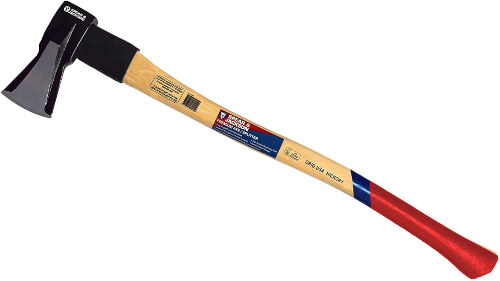
Spear & Jackson’s log splitter with its hardwearing hickory handle uses ergonomic design in the handle to reduce vibrations and shock for the user, with a lighter weight head that incorporates clever contours to split the timber more efficiently along the grain.
There are a few other similarly priced block splitters on review here and it does seem like the choice is between contoured heads and heavy heads, and it’s really up to you as to what you prefer.
Heavy heads take the work out for you, but are hard to lift, while the contoured heads are more efficient and lighter to lift, but need more swing force from the user.
Pros
Cons
3. Spear & Jackson Felling Hatchet with Hardwood Handle

Spear and Jackson are a great garden tool brand, making trusted tools that continue to cement their great reputation.
If you’re going to buy a hatchet axe, then this is the best you can buy, but there is an important distinction between hatchet axes and chopping axes, and a huger difference in weight.
While this is a really well-built tool, it’s for small jobs, and will be great for splitting already cut firewood into smaller pieces, or quickly tidying up branches in the garden, but it would take hours to cut down any medium or large tree with this tool.
Pros
Cons
4. Estwing Camper's Axe with Shock Reduction Grip

The Estwing Hatchet Axe has the same problem as any other hatchet axe here. For big jobs, it’s just not heavy enough, at just 1kg there’s not enough weight behind the tool to make any significant cuts to tree trucks.
However, with its forged steel construction it’s probably the most durable tool on review here with no weak points across its handle or blade, meaning it will last for many years as a reliable garden tool.
Just don’t use the Estwing hatchet axe for tree felling.


Get Your Free Guide:
Master Growing Australian Natives eBook
A Must Have Complete Guide for Every Australian Garden
Get Your Free Guide:
Master Growing Australian Natives eBook
A Must Have Complete Guide for Every Australian Garden
Pros
Cons
5. Fiskars Chopping Axe

While this is a pretty lightweight axe, its length, and blade performance makes up for the overall weight, and in fact, the lightweight handle makes it much easier to use.
It does rely almost entirely on the blade to cut though, so you’re completely in charge as the user, rather than relying on the overall weight, but that actually helps in many ways, with hundreds of users reporting it performed better than any other axe they had used.
With lightweight axes that rely on the blade, make sure you buy a good whetstone or sharpening file along with it to keep the blade clean and sharp.
Pros
Cons
6. Spear & Jackson Axe with Fibreglass Handle

The blade and axe head on this axe from Spear & Jackson weighs 1.13kg so it packs a good punch, but the added weight of the handle brings it up to 1.8kg, making it easier to control, and adding that extra bit of weight you need to make a real impact, fast.
The fibreglass handle is sturdy and built to fit the forged blade perfectly which helps to control shock and vibrations during heavy use.
As well as being from one of the most trusted garden tool brands, and packing a seriously effective punch, it’s great value too, so you’ll get better value for money with the multi-purpose Spear & Jackson Axe than any other axe.
Pros
Cons
7. Garden Master Axe Splitter

At almost 1m long, this log splitter from Garden Master is a super-efficient tool, but it does rely on the swing almost as much as its weight.
While the lightweight head does mean you need to do the work by swinging downwards, its shock-absorbing handle makes it comfortable to use and means you’re less likely to break your back in the process.
Pros
Cons
Axe and Block Splitter Top Picks for 2025
Top Rated Block Splitter


The best tools are always multi-purpose, and that’s no different for block splitters and axes. Spear & Jackson Block Splitter doubles up as a sledgehammer (hence the common title sledge axe), so it’s great for demolition, and if you’re thinking ahead, you could use it to build your fire pit, then use it to split the wood to burn.
As well as looking good, the hickory handle helps to absorb shock and adds to the weight which increases the impact on any timber for splitting, which makes the whole job easier for you.
Best Value Block Splitter


Spear & Jackson never normally come cheap, so I was really pleasantly surprised to find a tool of this quality, by a brand as trusted as Spear & Jackson for such a good price.
Spear & Jackson Axe is the best value axe you can buy right now. With a heavy-duty head, sturdy fibreglass handle, and an easy to sharpen blade, it’s suitable for any tree felling job and takes chuck after chuck out of tree trunks when they need felling thanks to the hardened carbon steel head.
Axe and Block Splitter Buying Guide
Difference Between a Block Splitter and an Axe
The difference between a block splitter and an axe is that an axe is for cutting and a block splitter is for splitting. When properly used, an axe uses the force of its user to hack and cut away sections of timber in any direction.
A block splitter uses its own weight to hammer down a tapered mallet in the direction of the wood grain, forcing the timber to split apart.
When to use an axe?

An axe is a great tool for jobs of any size, and because of that axes come in all sizes. Short handles axes are handy tools for splitting small sections of timber, removing branches and can even be used for delicate carving work in the right hands, but the most famous use for a long handle axe is felling trees.
Because axes are reasonably lightweight, they are easy tools to swing and provided you know how to use one, they can make light work of trees in no time.
You’ll notice when using an axe to fell a tree that you’re taking chunks out of the trunk. This is because axes are for cutting, not splitting.
When to use a Block Splitter?
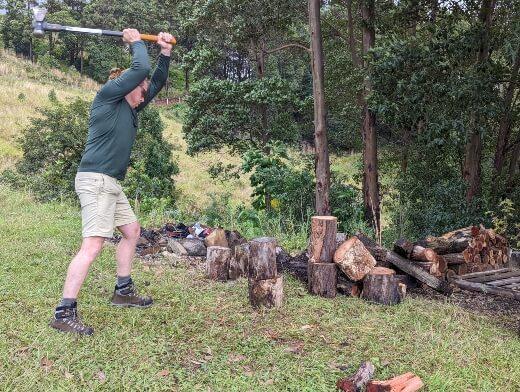
Nathan Schwartz of Aussie Green Thumb demonstrating how to use a block splitter
Block splitters are for narrowing existing logs and timber pieces from already felled trees, either for firewood, or just to make large logs easier to transport.
Block splitters have a two-sided head, with one side usually doubling up as a sledgehammer, hence their other names; block splitters are also known as a sledge axe, maul axe, chop and maul, block buster and ham axes.
The weight of their cast iron heads makes them incredibly heavy so they should never be used for felling as you’ll just tire yourself out.
Block splitters also tend to have blunt axe blades which means they don’t hack away useful timber and instead drive through like a wedge along the grain of the wood.
What to Look For When Buying Axes
There are only really two things to consider when buying an axe; materials and weight. The better the materials, the longer your axe will last, and the lighter it is, the less damage you’ll do to yourself and it.
Never compromise on the material of the axe head, but look at the handle material so you know you’ll be able to comfortably swing the axe.
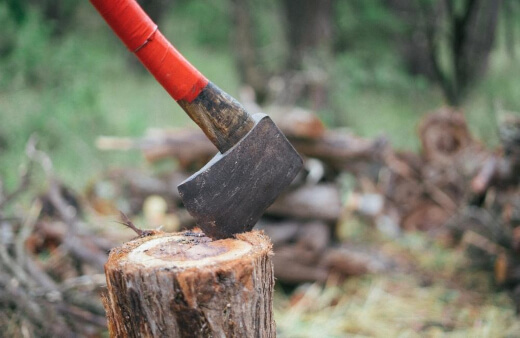
What’s the Best Weight for an Axe?
An axe that weight less than 1.8kg is unlikely to have the impact you need to cut wood, and an axe over 2.7kg is going to be too heavy for repeat swinging, so the best axes weigh around 2-2.5kg making them impactful, but not so heavy that you can’t use them for long periods.
What’s the Best Blade Material for an Axe?
The best axes use forged carbon steel which reduces crack points and fissures in the axe head after repeated use. Steel is the best material for axes because of its durability, and how simple it is to sharpen, without compromising on the strength as steel will always be tough enough to cut through softwood, and most hardwoods, without the extreme weight of cast iron.
What to Look For When Buying Block Splitters
Block splitters are the heavy-weight alternative to standard axes, making light work of log splitting. When choosing your new block splitter be aware of your own abilities and don’t overstretch.
Block splitters rely on weight, so the heavier the splitter, the more efficient it is, but as long as the user can actually lift it over their heads repeatedly.
What’s the Best Weight for a Block Splitter?
Block splitters should really be as heavy as you can swing. 3.5kg is usually about right for a good, heavy-duty block splitter, giving you the force to split timber without much need to swing.
Essentially, the heavier the blade on the splitting head the more power you’re exerting on the log, and the more likely it is to split the first time.
As well as weight, look at the shape of the block splitter head. Traditional block splitters have simple blunt blades that widen out to the sledgehammer edge on the other side.
Modern block splitters have more contouring on the blade which helps direct the pressure through the wood grain, making it faster to split large logs. It doesn’t add to the weight, but it puts the weight to more efficient use.
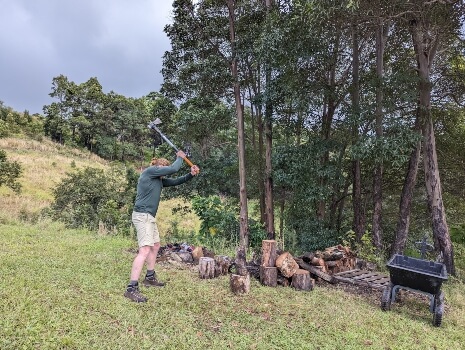
Nathan Schwartz splitting a log with the help of a block splitter
What’s the Best Hammer Material for a Block Splitter?
Block splitters should be made out of materials that are easy to maintain, and able to withstand high impact, so timber handle block splitters should be made out of hardwood like hickory, or heavy-duty fibreglass to help reduce vibrations.
The hammer itself should be made from carbon steel, just like any axe, which makes it tough enough to withstand force, better for maintenance, and easier to store without rust.
Axes & Block Splitters FAQs

How much does an axe cost?
Axes can cost anything from $20 to $200 and the biggest factor in pricing is almost always brand, so make sure you’re looking at the specifications of the axe you’re buying as you could easily save yourself $100 and get an identical axe from an unknown brand.
How do you sharpen an axe?
Axes should be sharpened as often as possible. Sharper blades work faster and can save you hundreds of strikes on a large tree. To sharpen your axe, find a sharpening file or whetstone, and draw it over the blade in one direction, never back and forth until any patina has gone and the blade is sharp enough to cut through paper without pressure.
Should a block splitter be sharp?
A block splitter should never be sharp, but you should try to keep the blade from becoming completely blunt by sharpening lightly every so often, or even grinding it back into shape with a bench grinder when you have time.
Sharp splitting axes cut rather than split, while well-rounded heads wedge through the grain instead.
Can you chop wood with a block splitter?
Block splitters are great for splitting timber down as firewood or for transportation, but they should never be used for chopping down trees or cutting against the grain of a log.
Because the blades of block splitters are blunt they will take hundreds more strikes to cut through any timber than a sharp axe.
For more buying guides, see our list below:
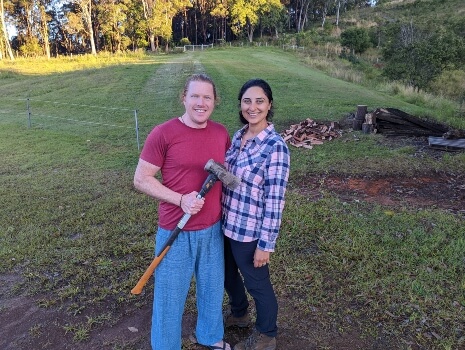
Nathan Schwartz of Aussie Green Thumb
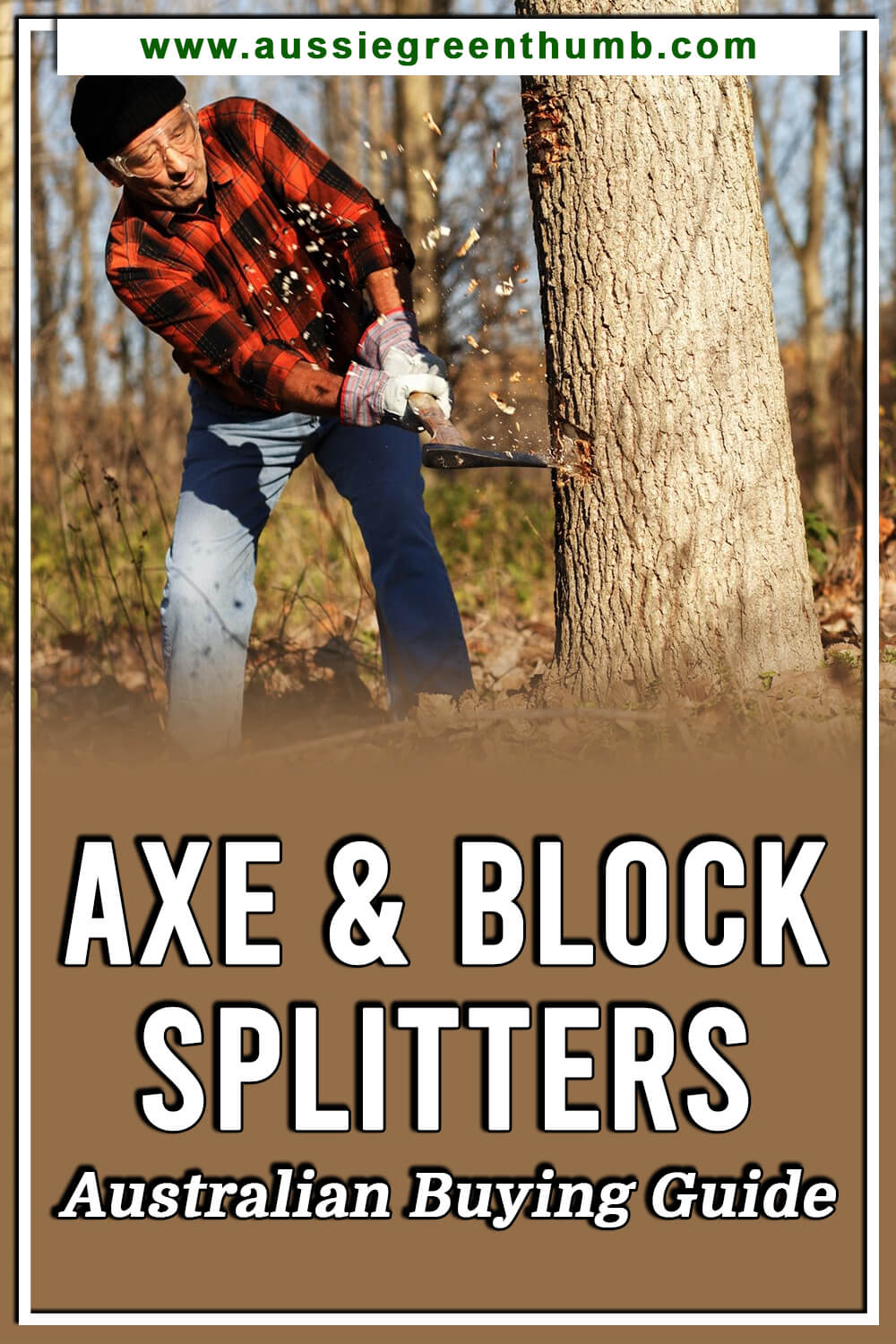
Get the Best Axe or Block Splitter Today
If you’re a contractor looking for your next axe, our premium axes are definitely worth considering for your next project, but for domestic gardeners, whether you’re considering the best axe to buy, or just looking for a good budget axe in 2025, then there’s enough choice above to get you started.
And remember that tree surgeons are expensive, so as long as you know what you’re doing, you can buy an axe or a block splitter for a fraction of the cost of a tree surgeon and get rid of overgrown or problem trees yourself without the high fees that go with it.
Published on March 19, 2022 by Gary Clarke
Last Updated on December 27, 2025




